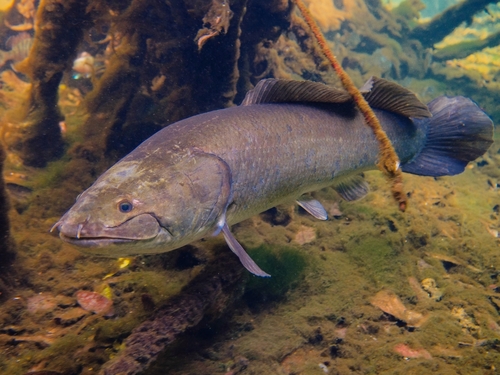
Bowfin
The Atlantic Bluefin Tuna (*Thunnus thynnus*) is a majestic and powerful fish, renowned for its incredible size, speed, and migratory journeys. This apex predator plays a crucial role in the marine ecosystem and holds significant cultural and economic value.
10 30 years
Lifespan
50 - 109 cm
Length
Least Concern
Conservation Status
8 km/h
Swimming speed
Carnivorous, Insectivorous
Diet
Local Migration
Migration
Appearance Overview
The Atlantic Bluefin Tuna is renowned for its large, streamlined body, built for speed and endurance.
Coloration
Dark metallic blue above, silvery-white below
Body Shape
Torpedo-shaped, with a robust and streamlined body
Fins
Two dorsal fins, the first depressible; small, yellow finlets running from the dorsal and anal fins to the tail
Scales
Small and cycloid (smooth-edged)
Length
Up to 13 feet (4 meters), commonly around 6.5 feet (2 meters)
Weight
Up to 2,000 lbs (907 kg), commonly around 550 lbs (250 kg)
Diet
Carnivorous, feeding on a variety of fish (such as herring, mackerel, and hake), squid, and crustaceans.
Feeding Behavior
Highly active predator, often hunting in coordinated schools. They use their speed and agility to chase down prey.
Social Behavior
Forms large schools, especially during migration and spawning. Schools are often segregated by size.
Commercial Relevance
Extremely high value, particularly in the sushi and sashimi markets in Japan. It is one of the most expensive fish in the world.
Conservation measures
Subject to international fishing quotas and management plans under organizations like ICCAT. Marine Protected Areas and fishing gear restrictions are also in place.
Status
Endangered (Varies by population segment; some are considered critically endangered).
Threats
Overfishing (primarily for sushi/sashimi), bycatch in fishing gear intended for other species, habitat degradation, and climate change affecting prey distribution.
Habitat Distribution
Depth Range
0-3,280 feet (0-1000 meters), though they commonly inhabit surface waters to around 656 feet (200 meters).
Geographic Range
Atlantic Ocean, including the Mediterranean Sea. Western Atlantic population, Eastern Atlantic and Mediterranean population.
Preferred Environment
Pelagic (open ocean), ranging from temperate to subtropical waters. They prefer areas with specific temperature ranges that vary with their life stage.
Reproduction and Life Cycle
Breeding Habits
Spawns in warm waters, with major spawning grounds in the Gulf of Mexico and the Mediterranean Sea. Spawning typically occurs during spring and summer.
Development Stages
Eggs hatch into larvae, which are planktonic. They grow rapidly, developing through juvenile stages before reaching maturity. Growth rates are influenced by water temperature and food availability.
Fecundity
Highly fecund; a single female can produce up to 30 million eggs per spawning season. The eggs are buoyant and float in the water column.
Maturity Age
Maturity age varies by location. Western Atlantic population matures around 8-12 years, while the Eastern Atlantic and Mediterranean population matures earlier, at around 4-5 years.
Faqs about Bowfin
How long do Atlantic Bluefin Tuna live?
Atlantic Bluefin Tuna can live up to 40 years, although this is becoming less common due to overfishing.
Where can I find Atlantic Bluefin Tuna?
They are primarily found in the Atlantic Ocean, ranging from the cold waters of the North Atlantic to the warmer waters of the Gulf of Mexico and the Mediterranean Sea.
Do Atlantic Bluefin Tuna migrate?
They are highly migratory and can travel thousands of miles across the Atlantic Ocean for feeding and spawning.
Are Atlantic Bluefin Tuna warm-blooded?
Yes, they are warm-blooded, which allows them to maintain a higher body temperature than the surrounding water, aiding in their speed and endurance.
How many eggs do female Bluefin Tuna lay?
Females can release millions of eggs (up to 30 million) during a single spawning season.
What are the predators of Atlantic Bluefin Tuna?
They are apex predators with few natural predators, primarily large sharks and marine mammals. Young tuna are more vulnerable to predation.
How fast can Atlantic Bluefin Tuna swim?
They can swim at speeds up to 43 mph (70 km/h) in short bursts, making them one of the fastest fish in the ocean.
What is the biggest threat to Atlantic Bluefin Tuna?
The main threat is overfishing, driven by high demand in the sushi market. This has severely depleted their populations.
Is it ethical to eat Atlantic Bluefin Tuna?
It is best to avoid consuming Bluefin Tuna, or look for responsibly-sourced alternatives, due to the species' endangered status. Check for certifications like MSC.
How deep can Bluefin tuna dive?
Bluefin tuna can dive very deep. They dive to depths of more than 3,000 feet (900 meters).
Copyright @ Nature Style Limited. All Rights Reserved.
 English
English